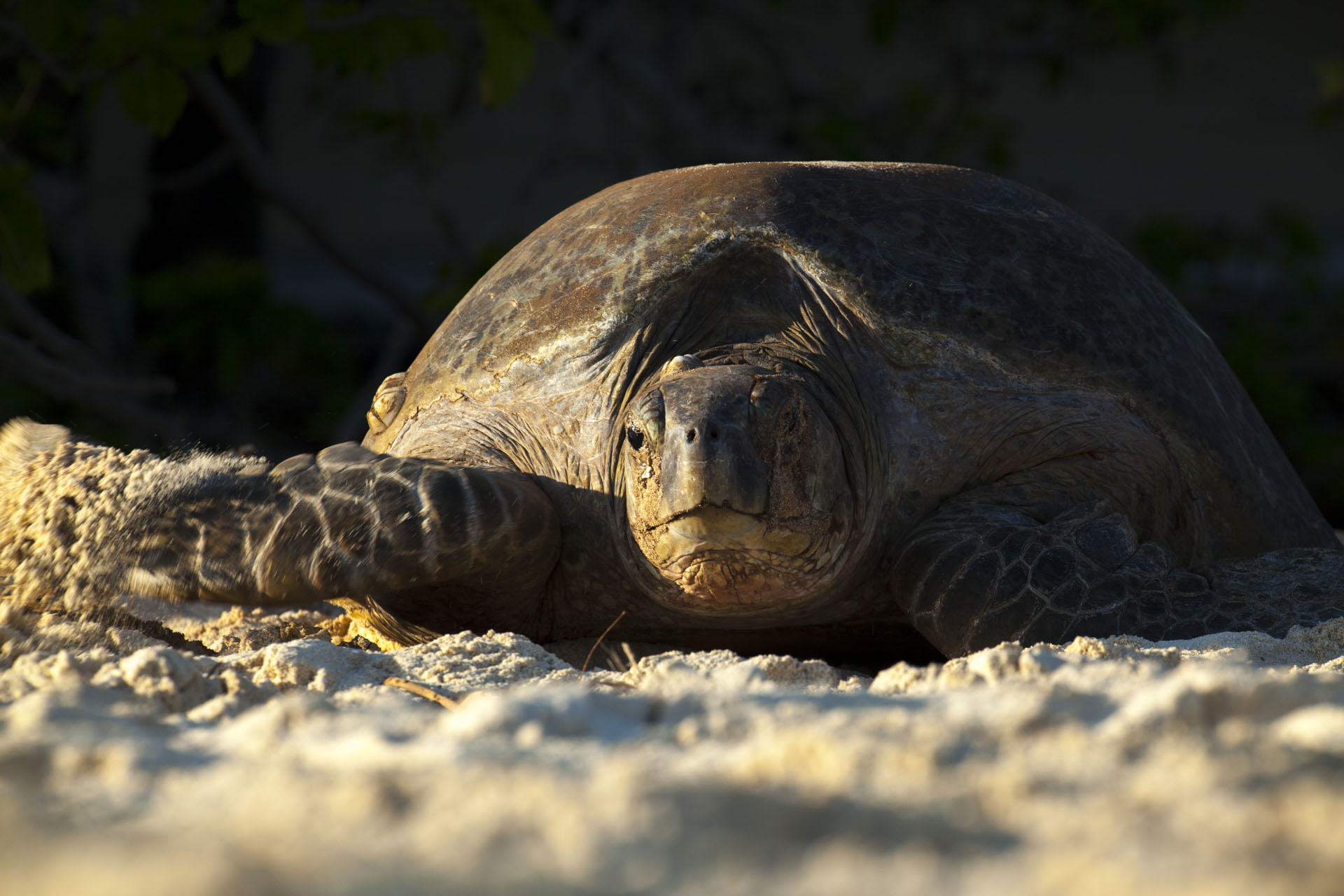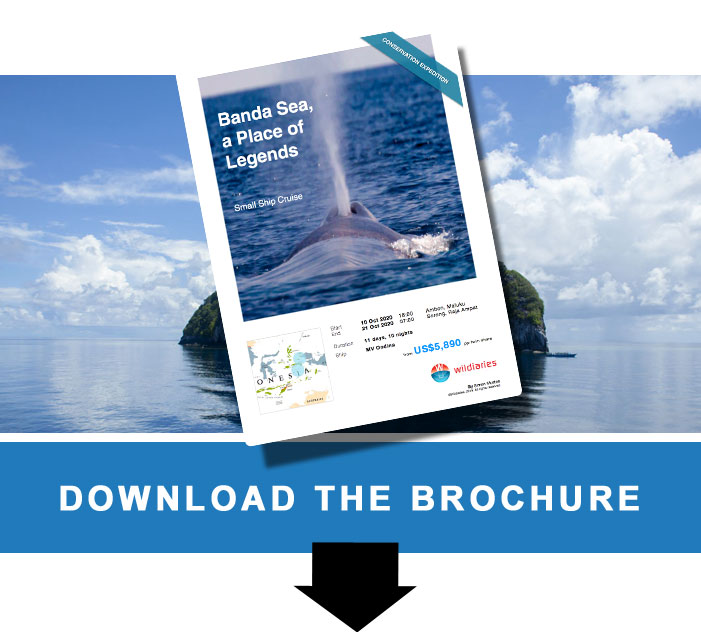
Totally Turtle on Heron Island
On the verandah of their beachfront chalet a family are enjoying morning coffee. In front of them a mother turtle has just laid fifty or so eggs in a deep chamber she dug furiously an hour earlier. In between audible sighs of exhaustion she’s back-filling the hole

A turtle completes its nesting cycle at dawn. Most turtles come up to nest on or near high tide and this one was not long before dawn.
As she pivots to face the sea, she pauses to gather breath before raising her head to suck in the morning’s cool air. She’s carried her mighty shell for decades. When she first emerged from Heron Island’s warm sands sixty or more years ago, it protected her from the stabbing beaks of Reef Egrets and then later, from attacks by rapacious Tiger Sharks.

A Queensland government turtle conservation officer checks the turtle’s flipper band. Identifying individuals has helped them understand the population biology in detail so they have the data to issue early warnings if there is any cause for alarm.
Today, under the weight of her armour and the almost incomprehensible necessity to carry herself high above the ocean to nest, she shares her most private moment with a few privileged onlookers.
For many it is not their first visit to ‘Heron’ as they know there isn’t anywhere on Earth that matches the island for wildlife. It’s been a tourism destination for decades. Newcomers are surprised to learn that turtle hatchling success here is among the highest anywhere on the Great Barrier Reef ... but this is one of few places tourists are allowed to tread lightly. To be able to share resort space sustainably alongside fifty thousand seabirds and thousands of turtles makes Heron Island almost globally unique.

Black Noddies are tree-nesting. They are essential for the nutrient processes that support the island’s vegetation.
Almost ready to head back to sea, our turtle repeatedly draws her hefty bulk up onto elbows and with a mighty push of her hind flippers, falls forward, inching down the beach between bouts of rest. Before meeting the ocean head-on, there is one final hurdle, a climb over abrasive coral rocks. As she disappears below the surf, we gather cameras and flip-flops and head to our pre-prepared breakfast buffet, freshly-squeezed orange juice and eggs-to-order.
The irony isn’t lost on any of the guests.
 The turtle lifts herself over a wave cut platform of rocks to reach the sea. Driven by instinct and with powerful front flippers, this is a process that has served them well for millions of years.
The turtle lifts herself over a wave cut platform of rocks to reach the sea. Driven by instinct and with powerful front flippers, this is a process that has served them well for millions of years.
The natural world is a constant struggle for survival and nowhere more perhaps than on the harsh outer frontiers of our blue oceans, where sunlight bakes the sand to dust and only the hardiest survive.
Staying on Heron Island is a stark reminder of the trials of life.
An ‘eruption’ of turtle nestlings is a fitting metaphor for what happens when, after as many as three days, newly-hatched turtles dig their way out from their catacomb where they spent the last two months growing inside a leathery-shelled egg. All surviving young from the nest burst out of a single hole, vying for pole-position, in a frenetic mad-dash to the outer reef.

Turtles born on Heron Island are mostly females because the deep sand is quite warm. Sex is determined by incubation temperature (climate change suddenly poses this most unique challenge for an animal that has existed for millions of years).
The turtles that emerge here will be at the mercy of ocean currents for many years to come. Swept around the Pacific they will endure at least 25 years in open water reaching as far as continental North America before eventually and instinctively, finding their way home. Only about one in a thousand ever make it back alive.

The egg-chamber has vertical sides but the bottom should be wider and spherical. In this case, the dry yellow sand below the surface was falling into the hole and this female abandoned the dig, preferring to return another day and try again. Recent rainfall offers some hope of better conditions to come.
Now is both nesting and hatching season but this year, unprecedented drought has befallen the island. Soils are thin and many turtles are abandoning their first few nesting attempts, finding it near-impossible to complete the spherical pit at the chamber’s base.
In one final desperate attempt, egg-bound females have been returning several nights later and excavating shallowly. The result is their clutch is more vulnerable to being dug up by other nesting turtles and when the hatchlings do finally emerge, rather than ‘erupt’, they may come out one by one, here and there - making them easier-pickings for marauding Silver Gulls and Black-tipped Reef Sharks.
 

Silver Gulls never used to breed on Heron Island. Coastal development on the mainland has given them the edge and this successful species has spread far beyond it’s previous range. This is a new threat the young turtles have to endure but there is work being done to try to control gull numbers.
Visitors might be forgiven for thinking nature is out of control but the island’s world-famous Heron Island Research Station hosts some of the reef’s longest-standing scientific studies. So we know the challenges young turtles face are essential for their survival.
Nesting also introduces nutrients and the deep depressions caused, makes a place for water to gather and plants to begin to grow. Heron Island is not an isolated haven but part of a bigger system. Every cay is different, from newly-formed sand banks to treed complexes, the quilted pattern of island-types and their protection across the whole Great Barrier Reef region, provides the elasticity needed for life to flourish. Islands act like the fuel reservoirs for oceans but it’s animals that pipe this around the world. A 2015 Oxford University study estimates this capacity has declined by up to 96%. So intact, fully-functioning ecosystems and healthy wildlife populations at places like Heron, are disproportionately important, even critical, for the future of our oceans.
 Each turtle digs a depression in the sand. Recent rainfall has begun to make it easier for the turtles to nest more deeply.
Each turtle digs a depression in the sand. Recent rainfall has begun to make it easier for the turtles to nest more deeply.
Without wildlife, Heron Island would be barren and treeless, vulnerable to erosion from the persistent tides and strong southeasterly trade-winds. Turtles and seabirds have instead manoeuvred Heron Island into a landscape rich in vegetation where it’s become possible for tourists, scientists and wildlife to thrive side by side. Here you can begin to understand how the consequences of losing animals, over and above any effects of a changing climate, would have the most far-reaching effects on our world.
To stop by, watch and accept the fate of a newborn turtle hatchling before gorging on an all-you-can-eat breakfast, is profoundly (if not perversely) humbling and perhaps why so many return to the island time and time again.
Yet the struggles are balanced by moments of sheer beauty and privileged encounters with animals that have long-become accustomed to human company - a confiding turtle that swims over to check you out; a Black Noddy that lands on your head; and the constant companionship of thousands of reef fish that occupy the reef-shelf’s every crack and crevice.

A juvenile turtle glides past. Many of these turtles were born here in the company of humans and have little fear.
How Heron Island tourists came to be so fortunate, no-one will ever know. For certain though, the choices every guest makes in the coming years, will be made with a greater appreciation of the debt mankind owes wildlife and Heron Island, one of our oceans’ most important places.
____________________________________
Cover photo: After completing the arduous task of nesting once more, this female turtle returns to the sea. She may nest several times this season. If not, she’ll hopefully be back again in the next couple of years or so.
Words and images by Simon Mustoe.


